Why biodiversity research keeps its feet dry Understand article
Marine ecologists Iris Hendriks, Carlos Duarte, and Carlo Heip ask why – despite its importance – research into marine biodiversity is so neglected.
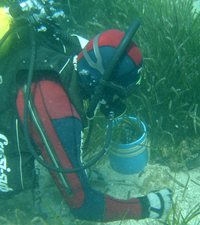
do get their feet wet. For
instance, in sea-grass meadows
(with Posidonia) near the coast
of Mallorca, Spain
Image courtesy of Iris Hendriks,
IMEDEA
Biodiversity on land receives much more attention – and attracts much more funding – than biodiversity in the oceans. This leaves 71% of the Earth’s surface unprotected and relatively un-researched (Hendriks et al., 2006). The sheer depths of the oceans are similarly undiscovered: according to the Census of Marine Lifew1, 95% of all known species of ocean life are recorded close to the water surface. By contrast, species observed below 2 km account for fewer than 0.1% of known species. If you were to collect a fish or bacterium at this depth, it would very likely be a species never before described!
Despite a valuable array of products from biological sources, some of which have been used in the battle against infectious diseases and cancer (Maris, 2006), commercial companies are not yet enthusiastic about ‘bio-prospecting’. It is difficult to produce high yields from invertebrate cultures, and the biotechnology industry claims that promising leads come faster and more frequently from a combination of chemistry and synthetic techniques.
By contrast, interest in marine micro-organisms – as a source of natural compounds and potential bases for future medicines, foods and biotechnological products – is beginning to grow. Microbes may not seem as interesting as furry and feathered land animals and colourful plants, but they are an important part of ecosystems and food chainsw2. And unlike invertebrates, they can be grown in large flasks and produce much higher yields. Marine researcher William Fenical and his colleagues from the University of California, San Diego, USA, for example, derived a compound from Salinospora, a bacterium found in deep-ocean sediment. It binds selectively to a protein found in tumour cells, and is now undergoing clinical testing for efficacy against multiple myeloma, a type of blood cancer.
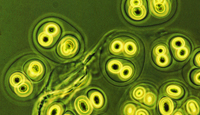
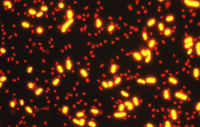
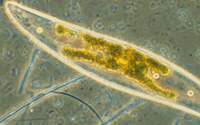
Who said marine microbes are not attractive? Together, the micro-organisms make up most of the ocean’s biodiversity and 90% of its biomass
Image courtesy of Ute Wollenzien & Lucas Stal, Netherlands Institute of Ecology
Modern marine researchers use a wide range of methods, both underwater and on dry land, to study oceanic biodiversity – they may send a submarine to the depths of the ocean in search of specimens, then analyse DNA samples in the laboratory. They explore the extent, value and function of life in the marine ecosystem (see box), and investigate who eats whom, and how this affects the nutrients in marine ecosystems locally and worldwide.
Biodiversity and ecosystem function
Trillions of organisms move hundreds of thousands of tons of chemical elements and compounds between the water, air and earth every year. This cycle ensures the fertility of soils and the quality of water and air. We are still learning how these organisms work together to form an ecosystem, and what happens when a species is introduced or lost.
There are three major hypotheses to explain how an ecosystem reacts when it gains or loses a species. First, one species may compensate for the loss of another by taking over its role in the ecosystem. In this scenario, a new species would add nothing to the ecosystem that was not already offered by the ‘flexible’ species present. In the second scenario, each species’ contribution is considered unique, and any loss or addition causes detectable changes to the ecosystem. Third, the effects of the loss or addition of a species depends on external variables, such as climate, and cannot be predicted.
Experimental manipulation of oceanic ecosystems is not easy, so scientists test these hypotheses by using mixed species of herbs and grasses instead. By growing a small number of plant species and comparing their growth and yield, the effects of the addition or eradication of a species can be studied. Although the interpretation of these grassland experiments and their applicability to other ecosystems is not straightforward, the investigations provide a model with which to test and further develop ideas.
Other ‘natural’ experiments can also provide valuable insight: the warming of the Earth and increased ship traffic across oceans can cause species to shift; and ‘exotic’ species can invade ecosystems and out-compete local inhabitan
A great loss
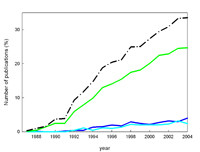
publications per year as a measure,
the effort put into biodiversity
research in terrestrial (green),
freshwater (light blue) or marine
(blue) habitats is clearly different.
More people and money are needed
for sea research! Click on image to
enlarge.
Image courtesy of Iris Hendriks, Carlos
Duarte & Carlo Heip
The marine environment faces many problems, including commercial fishing, coral bleaching, invading species, ecosystem degradation and extinction. Over-fishing and hunting of megafauna, such as large predatory fish (Myers & Worm, 2005), have removed much of the oceans’ fish biomass.
Key coastal habitats that nourish marine biodiversity and provide key functions to society – such as mangroves, sea-grass meadows, salt marshes and coral reefs – are declining between two and ten times faster than tropical forests.
Excess nutrients, sedimentation and contaminants are leading to a widespread deterioration of water quality, promoting oxygen deficiency and a loss in biodiversity near coasts (Lotze et al., 2006).
Another crucial problem is acidification caused by increasing CO2 emissions. This is a global threat, as acidic seawater can eventually dissolve or disintegrate calcifying marine life such as coral reefs, mussels, and unicellular planktonic organisms. This is damaging not only to nature but also to the economy, as bivalves like mussels and oysters are important food sources. Healthy coral reefs are also crucial, as they house many commercially important fishes and support ecotourism. So how can we solve this global problem?
Effective?
Although more than two-thirds of the Earth’s surface is covered by water, protected marine areas account for only 2.1 million km2, compared with 17.1 million km2 of protected terrestrial environment. Paradoxically, the major difficulty in creating marine nature reserves is the fact that the oceans are the patrimony of all nations: governments have been unwilling either to take unilateral action or to co-operate in preserving our marine heritage. Furthermore, evidence for extinctions in the ocean is still scarce: demonstrating extinctions is difficult when much of biodiversity of the oceans remains to be discovered.
Most protected marine areas are smaller than 100 hectares: far too small to be effective. Only the Great Barrier Reef in Australia (more than 345 000 km2) and a newly protected area near Hawaii, USA (360 000 km2), approach the effective size (Mora et al., 2006). Also, most protected areas are isolated, whereas evidence suggests that food webs are connected across oceans. To design a network of protected areas that truly preserves biodiversity, we need to better understand the connections between ecosystems.
Disconnected
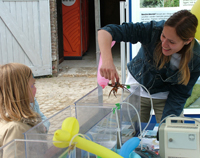
life to people is very important
Image courtesy of Netherlands
Institute of Ecology
Although links between ecosystems are significant, it is important not to overestimate the degree of connectivity. Conventional wisdom holds that extinctions are unlikely in the oceans, because marine organisms can be carried easily from place to place, replenishing populations that die out. However, recent research indicates that marine species may not be as widespread, populations might not be as interconnected, and the marine environment is probably not as resilient to extinction as was once thought. For example, recently discovered deep-sea habitats such as hydrothermal vents, cold seeps, brine lakes and whale carcasses harbour specialised communities that are isolated by hundreds or thousands of kilometres of sea floor.
Luckily, despite a bias towards terrestrial research, studies on marine biodiversity have increased greatly over the past few decades. Scientists must design effective marine reserves, elucidate food-web mysteries and find new species before it is too late. But we can all look after our oceans to preserve their biodiversity: be conscious of what fish we eatw3, value all species, join conservation societies, urge our governments to act (together), and participate in sea and coastal observations. It is time to get our feet wet!
References
- Hendriks IE, Duarte CM, Heip CH (2006) Biodiversity research still grounded. Science 312: 1715
- Lotze HK, Lenihan HS, Bourque BJ, Bradbury RH, Cooke RG, Kay MC, Kidwell SM, Kirby MX, Peterson CH, Jackson JB (2006) Depletion, degradation, and recovery potential of estuaries and coastal seas. Science 312: 1806-1809
- Maris E (2006) Drugs from the Deep. Nature 443: 904-9054
- Mora C, Andrèfouët S, Costello MJ, Kranenburg C, Rollo A, Veron J, Gaston KJ, Myers RA (2006) Coral reefs and the global network of Marine Protected Areas. Science 312: 1750-1751
- Myers RA, Worm B (2005) Extinction, survival or recovery of large predatory fishes. Philosophical Transactions of the Royal Society of London. Series B, Biological Sciences 360:13-20
Web References
- w1 – The Census of Marine Life is a worldwide project, with educational information and links to outreach programmes.
- w2 – The International Census of Marine Microbes makes an inventory of the smallest life forms in our oceans, with a large database.
- The micro*scope site at http://starcentral.mbl.edu/microscope/portal.php and Microbial Life at http://serc.carleton.edu/microbelife/ are also useful sites for educators and their pupils.
- w3 – Fish Online lists species that are fished responsibly.
- w4 – The EU Network of Excellence MarBEF (Marine Biodiversity and Ecosystem Functioning) has an outreach section with information for schools.
Resources
- The EurOcean website includes an overview of useful links.
- SeaOnScreen at www.seaonscreen.org (also ZeeInZicht at www.zeeinzicht.nl [in Dutch]), and Expeditie Zeeleeuw at www.expeditiezeeleeuw.be (to be replaced by Planeet Zee in 2008), are also useful.
- The Marine Conservation Society is a UK charity dedicated to caring for our seas, shores and wildlife. It provides links to many useful sites, including marine societies and initiatives in other countries.
Review
Although biodiversity is considered within many curricula, it is frequently restricted to the land. Oceanic biodiversity is much greater and yet less explored; some of the reasons for this are provided here.
This article can be used in class to stimulate thought and conversation, for example on the problems facing oceanic research, how over-fishing affects the environment, and how increasing sea temperatures affect habitats.
Shelley Goodman, UK





